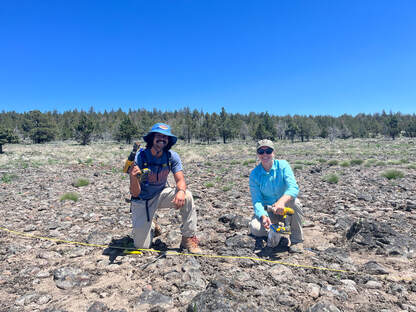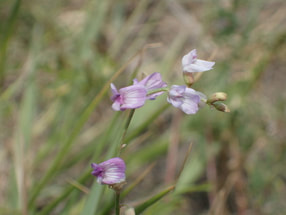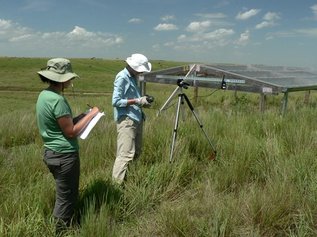RESEARCH
Research in the lab investigates the abiotic and biotic factors (and their interactions) that affect plant species dynamics and ecosystem function.
We employ a variety of research methods (e.g. experiments, long term observational data sets, statistical models) to answer questions pertaining to both fundamental and applied science in plant communities.
Student research is an important component of the lab. Interested students are encouraged to contact Dr. Byrne about research opportunities and see the people section of this website for current student projects.
We employ a variety of research methods (e.g. experiments, long term observational data sets, statistical models) to answer questions pertaining to both fundamental and applied science in plant communities.
Student research is an important component of the lab. Interested students are encouraged to contact Dr. Byrne about research opportunities and see the people section of this website for current student projects.

Targeted grazing to control exotic species invasion and restore plant communities
Ranchers and land managers in the United States spend billions of dollars annually to control invasive plants, such as cheatgrass and medusahead – invasive annual grasses that can outcompete native plant species and increase wildfire risk on western rangelands.
Efforts to restore native perennial species through seeding projects are also costly, often with low and unpredictable germination rates. A growing body of evidence suggests that livestock grazing, particularly fall and spring targeted grazing, may reduce invasive annual grass abundance through biomass and litter removal of annual grass while perennial species are dormant. However, treatment of invasive species in isolation will be unsuccessful if there is no longer a sufficient seed source for native species to return without further assistance.
The soil seed bank is a critical and understudied component of rangeland plant communities. Seed banks contribute to plant species persistence and recovery after disturbance and provide a signature of past, present, and future characteristics of the aboveground plant community. Furthermore, the seed bank can be used as a
resource for restoration efforts after undesirable species (such as exotic annual grasses) have been removed.
The lab currently is involved in two projects related to targeted grazing in annual grass invaded rangelands. Here is a recent talk Dr. Byrne gave with the Idaho Native Plant Society about this work.
1) Seeds underhoof: can the soil seed bank facilitate restoration of sheep-grazed, cheatgrass-invaded rangelands?
In this project with collaborator Kelly Hopping (Boise State University), we will examine relationships between aboveground vegetation composition and belowground seed bank composition across a range of cheatgrass invasion levels spanning different targeted grazing treatments by sheep in high elevation sagebrush steppe in Idaho.
Funding: Western Sustainable Agriculture Research and Education sabbatical grant program SW23-944
2) Quantifying the effects of herbicide and targeted grazing on medusahead thatch and the soil seed bank over time
In collaboration with the Bureau of Land Management, we seek to understand how the combined impacts of herbicide (impazapic) and fall targeted grazing by cattle affect the quantity of medusahead thatch, soil microclimate, and seed bank dynamics of a winter annual dominated grazing allotment located within the sagebrush steppe in eastern Oregon.
Funding: Bureau of Land Management Invasive and Noxious Plant Management Program grant L22AC00317
Ranchers and land managers in the United States spend billions of dollars annually to control invasive plants, such as cheatgrass and medusahead – invasive annual grasses that can outcompete native plant species and increase wildfire risk on western rangelands.
Efforts to restore native perennial species through seeding projects are also costly, often with low and unpredictable germination rates. A growing body of evidence suggests that livestock grazing, particularly fall and spring targeted grazing, may reduce invasive annual grass abundance through biomass and litter removal of annual grass while perennial species are dormant. However, treatment of invasive species in isolation will be unsuccessful if there is no longer a sufficient seed source for native species to return without further assistance.
The soil seed bank is a critical and understudied component of rangeland plant communities. Seed banks contribute to plant species persistence and recovery after disturbance and provide a signature of past, present, and future characteristics of the aboveground plant community. Furthermore, the seed bank can be used as a
resource for restoration efforts after undesirable species (such as exotic annual grasses) have been removed.
The lab currently is involved in two projects related to targeted grazing in annual grass invaded rangelands. Here is a recent talk Dr. Byrne gave with the Idaho Native Plant Society about this work.
1) Seeds underhoof: can the soil seed bank facilitate restoration of sheep-grazed, cheatgrass-invaded rangelands?
In this project with collaborator Kelly Hopping (Boise State University), we will examine relationships between aboveground vegetation composition and belowground seed bank composition across a range of cheatgrass invasion levels spanning different targeted grazing treatments by sheep in high elevation sagebrush steppe in Idaho.
Funding: Western Sustainable Agriculture Research and Education sabbatical grant program SW23-944
2) Quantifying the effects of herbicide and targeted grazing on medusahead thatch and the soil seed bank over time
In collaboration with the Bureau of Land Management, we seek to understand how the combined impacts of herbicide (impazapic) and fall targeted grazing by cattle affect the quantity of medusahead thatch, soil microclimate, and seed bank dynamics of a winter annual dominated grazing allotment located within the sagebrush steppe in eastern Oregon.
Funding: Bureau of Land Management Invasive and Noxious Plant Management Program grant L22AC00317
Restoring coastal dunes after yellow bush lupine invasion
The coastal dunes of Humboldt County are home to some of the most intact dune ecosystems in North America. Yet these local ecosystems are challenging to manage due to exotic species, despite major restoration efforts beginning in the 1980’s. One of the more important exotic species in the region is yellow bush lupine, an exotic nitrogen-fixing legume, which alters the chemical structure of the dunes by enriching the soils with nitrogen.
Previous studies have demonstrated that yellow bush lupine negatively affects the biological community long after plants are physically removed due to the impact on soil chemical processes. Even after removal, the nitrogen-rich patches in areas previously occupied by yellow bush lupine facilitate the invasion of exotic annual weeds into the plant community, at the detriment of the native “dune mat” vegetation. Despite the challenges of this invader, some studies have found success in immobilizing soil nitrogen by adding carbon sources to the soil. The goal of this new project, in collaboration with the US Fish and Wildlife Service, is to test the efficacy of carbon addition in reducing plant available nitrogen, thus decreasing the probability of future invasion by exotic grasses even after the yellow bush lupine has been removed. In spring 2019, a California Conservation Corps crew removed yellow bush lupine from a newly acquired parcel at Lanphere Dunes. We added carbon in the form of pulverized rice straw to fifteen 1.0 x 1.0 m plots, and are tracking changes in plant available nitrogen and species composition over time, compared to fifteen "control" plots where the lupine was removed, but no carbon was added.
The coastal dunes of Humboldt County are home to some of the most intact dune ecosystems in North America. Yet these local ecosystems are challenging to manage due to exotic species, despite major restoration efforts beginning in the 1980’s. One of the more important exotic species in the region is yellow bush lupine, an exotic nitrogen-fixing legume, which alters the chemical structure of the dunes by enriching the soils with nitrogen.
Previous studies have demonstrated that yellow bush lupine negatively affects the biological community long after plants are physically removed due to the impact on soil chemical processes. Even after removal, the nitrogen-rich patches in areas previously occupied by yellow bush lupine facilitate the invasion of exotic annual weeds into the plant community, at the detriment of the native “dune mat” vegetation. Despite the challenges of this invader, some studies have found success in immobilizing soil nitrogen by adding carbon sources to the soil. The goal of this new project, in collaboration with the US Fish and Wildlife Service, is to test the efficacy of carbon addition in reducing plant available nitrogen, thus decreasing the probability of future invasion by exotic grasses even after the yellow bush lupine has been removed. In spring 2019, a California Conservation Corps crew removed yellow bush lupine from a newly acquired parcel at Lanphere Dunes. We added carbon in the form of pulverized rice straw to fifteen 1.0 x 1.0 m plots, and are tracking changes in plant available nitrogen and species composition over time, compared to fifteen "control" plots where the lupine was removed, but no carbon was added.

Conservation of Applegate's milkvetch
Applegate's milkvetch (Astragalus applegatei) is a critically endangered plant species that is a narrow endemic of the Lower Klamath Basin in Southern Oregon, within the city of Klamath Falls. Once thought to be extinct, it is now know to exist at only a few sites within the Lower Klamath Basin. The lab has been conducting research on Applegate's milkvetch since 2013. We have several ongoing projects related to different aspects of Applegate's milkvetch conservation:
Each of these projects will assist Federal, State, and Local agencies in planning future conservation efforts, and are vital for the recovery of this imperiled species.
Applegate's milkvetch (Astragalus applegatei) is a critically endangered plant species that is a narrow endemic of the Lower Klamath Basin in Southern Oregon, within the city of Klamath Falls. Once thought to be extinct, it is now know to exist at only a few sites within the Lower Klamath Basin. The lab has been conducting research on Applegate's milkvetch since 2013. We have several ongoing projects related to different aspects of Applegate's milkvetch conservation:
- The United States Fish and Wildlife Service (FWS) has worked with a local nursery to improve propagation techniques. In 2012, 2013, and 2014, volunteers and biologists from the FWS augmented one of the protected populations by out-planting hundreds of A. applegatei seedlings that have been propagated in the greenhouse. To date, no thorough demographic monitoring program has established the success of this out-planting program. We conducted thorough demographic monitoring of all out-planted individuals at this site over six years, tracking seedling survival, reproduction, and recruitment, and compared vital rates of the out-planted individuals to extant individuals at the same site as they aged (Stewart and Byrne, in review).
- We have conducted annual demographic monitoring in four extant populations since 2016 to develop population models to predict future population dynamics of each population (Stewart, Byrne, & Jules, in prep).
- Three OIT undergraduates completed a study to learn more about the reproductive biology of Applegate's milkvetch (Byrne et al., in prep).
- With Catalina Cuellar-Gempeler (Cal Poly Humboldt Biology) we are investigating the role of the microbial community in the success of Applegate's milkvetch population growth.
Each of these projects will assist Federal, State, and Local agencies in planning future conservation efforts, and are vital for the recovery of this imperiled species.

Ecosystem response to global environmental change
With co-Principal Investigator Dr. Kristen Kaczynski (California State University, Chico) and Dr. Justin Luong (Cal Poly Humboldt) we are investigating the impacts of intense, long-term drought on the western Great Basin sagebrush ecosystem. The experiment is part of a large network of concurrent drought experiments, called the International Drought Experiment. This project aims to help inform future management decisions for the Bureau of Land Management.
Dr. Byrne's dissertation research examined the effects of precipitation changes on plant species composition and community structure in native grassland communities in the Great Plains of North America. She used a field experiment to manipulate rainfall in three treatments- control, water addition, and drought - and measured changes in species composition (Byrne et al. 2017) and aboveground (ANPP) and belowground (BNPP) net primary production (Byrne et al. 2013) in each treatment over 3-4 years. This research improved our understanding of ecosystem dynamics under climate change, especially BNPP dynamics, which are infrequently studied and not well understood.
In the same research framework, Dr. Peter Adler (Utah State University) and Dr. Byrne reversed the drought and water addition treatments at the more mesic mixed grass prairie site in Hays, KS, during the fourth treatment year to quantify the magnitude of community response to the switch between extreme above and below average precipitation years (Adler, Byrne, and Leiker, 2013).
With co-Principal Investigator Dr. Kristen Kaczynski (California State University, Chico) and Dr. Justin Luong (Cal Poly Humboldt) we are investigating the impacts of intense, long-term drought on the western Great Basin sagebrush ecosystem. The experiment is part of a large network of concurrent drought experiments, called the International Drought Experiment. This project aims to help inform future management decisions for the Bureau of Land Management.
Dr. Byrne's dissertation research examined the effects of precipitation changes on plant species composition and community structure in native grassland communities in the Great Plains of North America. She used a field experiment to manipulate rainfall in three treatments- control, water addition, and drought - and measured changes in species composition (Byrne et al. 2017) and aboveground (ANPP) and belowground (BNPP) net primary production (Byrne et al. 2013) in each treatment over 3-4 years. This research improved our understanding of ecosystem dynamics under climate change, especially BNPP dynamics, which are infrequently studied and not well understood.
In the same research framework, Dr. Peter Adler (Utah State University) and Dr. Byrne reversed the drought and water addition treatments at the more mesic mixed grass prairie site in Hays, KS, during the fourth treatment year to quantify the magnitude of community response to the switch between extreme above and below average precipitation years (Adler, Byrne, and Leiker, 2013).
Influence of precipitation seasonality and quantity on ecosystem net primary production
Understanding drivers of aboveground net primary production (ANPP) has long been a goal of ecology. Decades of investigation have shown total annual precipitation to be an important determinant of ANPP within and across ecosystems. Recently a few studies at individual sites have shown precipitation during specific seasons of the year can more effectively predict ANPP. In this project we determined whether seasonal or total precipitation better predicted ANPP across a range of terrestrial ecosystems, from deserts to forests, using long-term data from 36 plant communities. We found that examining seasonal precipitation can significantly improve ANPP predictions across a broad range of ecosystems and plant types, with implications for understanding current and future ANPP variation (Robinson et al., 2013).
Understanding drivers of aboveground net primary production (ANPP) has long been a goal of ecology. Decades of investigation have shown total annual precipitation to be an important determinant of ANPP within and across ecosystems. Recently a few studies at individual sites have shown precipitation during specific seasons of the year can more effectively predict ANPP. In this project we determined whether seasonal or total precipitation better predicted ANPP across a range of terrestrial ecosystems, from deserts to forests, using long-term data from 36 plant communities. We found that examining seasonal precipitation can significantly improve ANPP predictions across a broad range of ecosystems and plant types, with implications for understanding current and future ANPP variation (Robinson et al., 2013).